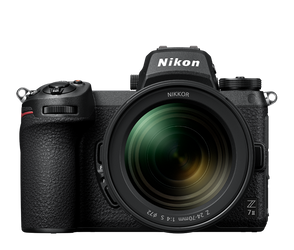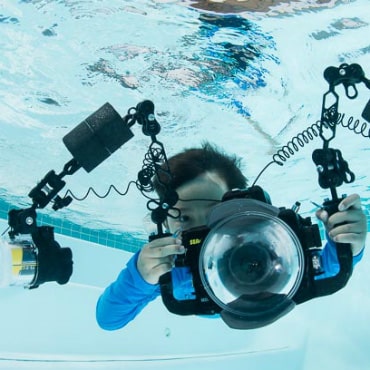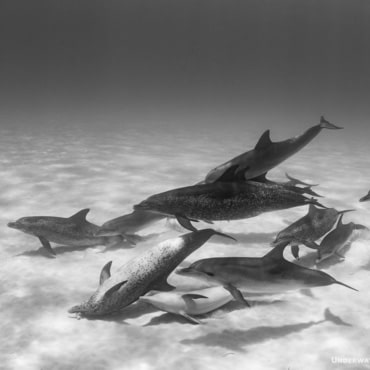Nikon Z6 II & Z7 II Underwater: Initial Thoughts & Review
October 30th, 2020
Nikon Z6 II & Z7 II Underwater: Initial Thoughts and Review
The Canon EOS R6 is Canon's newest prosumer level EOS R camera model released alongside the groundbreaking EOS R5. Despite being relized alongside a formidable older sibling, the R6 is not to be overlooked. For underwater photographers and videographers that don't need ultra high resolution photos and video, the R6 is most certainly the camera of choice for creatives that want the best bang for the buck.
Nikon Z6 II & Z7 II vs Nikon Z6 & Z7
Why choose the R6 over the 8K behemoth of the R5? The R6 still has all the bells and whistles of the R5 including In-Body Image-Stabilization (IBIS), 12 fps/20fps electronic burst shooting speeds, autofocus points covering 100% of the sensor, animal eye autofocus tracking, and more! In terms of video capability, it is capable of 4K @ 60fps using the full width of the sensor, which is more than enough for most underwater videographers. And the R6 ranks even better than the R5 for low light capability - making it a compelling camera for cold water underwater photographers. Overall, the R6 is the more rational choice for photographers looking for pro and enthusiast-level performance at a great price point.
We will be getting our hands on the EOS R6 to take underwater and show our loyal customers our results as soon as it is available!

Canon EOS R6
Staus: Camera Shipping August 27, 2020
Contact us at sales@bluewaterphotostore.com to preorder a housing and for updates on housing releases.
U.S. MSRP Canon EOS R5: $2,499
Jump to Section
EOS R vs EOS R6 | Specifications | Key Features
EOS R6 for Underwater Photo and Video | Who Should Buy? | Underwater Lenses
Underwater Housings | Conclusions
Purchase a Canon EOS R6 underwater housing at Bluewater Photo:
Nauticam Canon EOS R6 Underwater Housing
Ikelite Canon EOS R6 Underwater Housing
Sea & Sea Canon EOS R6 Underwater Housing
Aquatica Canon EOS R6 Underwater Housing
Isotta Canon EOS R6 Underwater Housing
Need help choosing a housing? Check out our Canon EOS R6 Underwater Housing Buyer's Guide
Canon EOS R6 Compared with Canon EOS R
The Canon EOS R was Canon's first attempt at a full-frame mirrorless camera. With many good options form Sony and Nikon, it fell short. Fortunately, the Canon EOS R6 addresses many of these concerns.
For underwater photography, Canon was lagging behind Sony and Nikon because of a lack of in-body image-stabilization. The Canon EOS R5 and R6 are Canon's first cameras with IBIS, capable of 7-8 stops of correction when combined with a stabilized lens. The EOS R6 also has the capability of shooting 12 frames per second with the mechanical shutter (20 fps electronic), vs the 8fps on the EOS R! Did we mention dual card slots?
The EOS R6 has a new 20.1 MP CMOS sensor, related to the sensor on the Canon 1DX Mark III. Strangely enough, this is actually less resolution than what was originally available on the 30.3 MP EOS R. It's a strange decision for Canon which prices the cameras at similar price points. In every other way, the EOS R6 is a more advanced camera, but we were disappointed to see such a low resolution. However, the lower resolution does help the R6 achieve amazing low light feats including lower noise in high ISO photos as well as high burst rates.
For underwater videography, Canon fell short of it's competitors by offering cropped 4K video in the EOS R. The EOS R6 goes above-and-beyond at addressing these concerns with 4K video up to 60 fps using an acceptabl 16:9 crop (1.07X). It should still be more than enough for most professional underwater videographers - especially compared to competitors like the Nikon Z6.

Canon EOS R6 Specifications
Key Canon EOS R6 Specs
- 20.1 Megapixel Full-Frame CMOS Sensor and Digic X processor
- Canon's first 5 axis In-Body Image-Stabilization (IBIS) which works in conjunction with optical IS RF and EF lenses. Up to 8 stops of correction
- Improved Dual Pixel II Autofocus
- ISO 100-102400
- 100% of the sensor has AF coverage!
- Animal eye AF detection (for birds, cats, and dogs) - we'll see if it works for fish!
- 12fps burst shooting with mechanical shutter
- 20 fps burst shooting with silent (electronic shutter)
- Dual card slots - 2x SD UHS-II
- 8K video @ 30p, 10- bit 4:2:2 - using the full width of the sensor!
- Internal C-Log recording
- 4K video up to 60 fps, 10-bit 4:2:2 (16:9, 1.07X crop)
- 3.69 million dot EVF
- Dimensions: 138.4 mm X 97.5mm X 88.4 mm
- Weight: 680grams (including battery)
Canon EOS R5 Key Features
Body and Build
The Canon EOS R6 is built similarly to the EOS R and EOS R5. Even though it's a mirrorless camera, it's only a tad bit smaller than its DSLR counterparts. In most cases, due to the size of RF and EF glass, we think underwater housing manufacturers will need to use their DSLR port systems. Therefore, we anticipate the full EOS R6 underwater system to be about the same size as a DSLR system, despite the added size benefits of mirrorless cameras. We expect the EOS R6 to need a seperate housing from the R5 and EOS R, despite there only being a 3 mm difference between the width of the R6 and R5. The R6 is slightly lighter than the R5.
The button placement on the camera is very natural. Canon users should be able to easily adapt to the system and the ergonomics of the EOS R6 are splendid. It just might be the best in its class of mirrorless camera across all brands. Canon discontinued the use of the touch bar that many found annoying on the original EOS R. They replaced it with a classic joystick control and added a wheel to the D-pad. We think these button improvements will make it an even more compelling camera from the standpoint of useability - clearly surpassing the Sony A7R IV and even the Nikon Z7.
Overheating Concerns
Almost immediatley following the release of the R5 and R6, concerns about overheating when shooting high resolution video surfaced. For the sake of size, the EOS R6 body does not have a built in cooling system. Therefor, when shooting 4K @ 60p there is a 30 minute time limit at room temperature before the camera overheats. This isn't quite as limiting as the R5 in 8K, but it is a cause for concern for many underwater videographers. At 4K @ 30p the camera can record for 40 minutes. Coldwater divers might be able to get longer run times out of the camera before needing to take a break from recording, but warm water divers could suffer shorter times. Either way, we recommend adding dessicant packets to your system to minimize fogging.
Image Quality and Processing
The Canon EOS R6 uses a similar sensor to the one found in the Canon 1DX Mark III. Although it's a lower resolution than the Canon EOS R, at 20.1 megapixels, it shouold be plenty of resolution for the everyday prosumer user. Moreover, because each pixel is larger, the EOS R6 should be capable of capturing photos with less noise than the R5. Unless you're an avid macro photographer that likes to crop photos to encapsulate details, we think the R6 should have enough resolution for most underwater photographers. Overall, the benefits of IBIS, burst shooting, and 4K @ 60p video outway the EOS R's original 30.3 MP.
Because Canon kept the resolution a little lower than standard, the R6 is capable of amazing feats with the Digic X processor. This includes burst shooting rates of 12 fps (20 fps with the electronic shutter). With a RAW buffer capacity of 240 shots, you'll be able to capture literally any action - no matter how quick! It's important to note that the R5 is capable of a 180 shot buffer with a CFexpress card, so photographers that like to capture quick animals may want to consider the R6 instead.
Canon EOS R6 for Underwater Photography
The Canon EOS R6 will clearly be one of the best tools on the market for underwater photography. It's the perfect tool for underwater photographers looking for amazing technical specifications for a great price point. Dollar for dollar it is perhaps one of the most valuable cameras on the market. With amazing burst speeds of up to 12 fps mechanical and 20 fps electronic, the EOS R6 will be an excellent camera for wide angle shooters who need to photograph quick, moving subjects. Canon's first rendition of IBIS in a camera promises 7-8 stops recovered with an image stabilized lens. That's going to be exciting for cold water underwater photographers that shoot in low lighting situations.

Canon EOS R6 for Underwater Video
The Canon EOS R6 is just as capable for underwater video as it is for photgoraphy. The R6 (almost) solves one important issue raised with the original EOS R - there's (almost) not 4K crop! We say almost because the R6 captures 4K in 16:9, not DCI - utilizing 94% of the sensor width. Although this results in a 1.07X crop, it is not enough to cause any issues with field of view. Videographers will still be able to make use of their lenses. Moreover, 4K video at 60fps is very compelling for underwater videographers who would like to slow down their footage for added stability. Competitors like the Nikon Z6 can only shoot 4K @ 30 fps.
Who Should Consider Purchasing the Canon EOS R6?
The Canon EOS R6 should be seriously considered as a camera of choice by experienced enthusiasts and professionals looking for a camera at a great price points. It might not have the resolution of the R5, but it certainly has the capability. So if you're ok giving up some detail, while retaining enough every day use, then you can't go wrong with the R6.
Lens Options for Underwater Photography
Because the RF lens mount is so new, there are a couple RF lenses that could be viable for both wide angle and macro photography in the future (e.g., Canon RF 15-35mm f/2.8L for wide and RF 35mm f/1.8 IS Macro for semi-macro and portraits) – but nothing quite as good as the available EF and EF-S lenses with the EF-EOS R adapter.
Recommended Underwater Lenses with the EF-EOS R adapter
Macro
Macro lenses enable to you get close up shots of little critters.
Canon EF-S 60mm f/2.8 Macro: This is a great all-around macro lens. It is easier to use than the 100mm macro lens and focuses quicker. However, it has less working distance than the 100mm so it is more difficult to get shots of skittish subjects. This is the recommended lens for blackwater diving.
Canon EF 100mm f/2.8L Macro IS: This is the best macro lens for small and shy subjects due to a larger working distance. It’s also an essential tool for supermacro photography when combined with a macro diopter. We tested this lens with the Canon EOS R and loved how sharp the photos were and the working distance for skittish subjects. If you are new to macro photography, it would be better to start with the 60mm macro for faster autofocus speeds.
Nauticam Super Macro Converter: The Nauticam super macro converter (SMC-1) is a wet diopter that can help capture sharp macro and super macro images. It’s the strongest, sharpest diopter on the market. If you are a super macro photographer, this diopter is best used with the Canon 100 mm f/2.8 macro.
Wide Angle Fisheye
Wide angle fisheye lenses allow for an ultra-wide field of view but result in a distorted image. The distortion is reduced underwater to the angle of refraction of light through the water.
Canon 8-15mm f/4L circular fisheye: This is going to be the best choice for a full-frame fisheye lens. At 8mm, the lens vignettes over itself creating a cool, artistic, circular fisheye affect. For traditional fisheye images, just zoom into 15mm and you will capture beautiful ultra-wide angle shots without vignetting. We tested this lens with the Canon EOS R and loved its functionality and quick autofocus with autofocus tracking.
Rectilinear Wide Angle
Rectilinear wide angle lenses retain a wide field of view but do not exhibit the distortion found on fisheye lenses. They are great for large animals like sharks and reefscapes.
Canon 16-35 f/2.8 III Ultra-Wide Zoom lens: This lens is the best choice for those who are buying their first wide-angle lens and don't have a strict budget. Most underwater shooters use rectilinear wide-angle lenses for shooting subjects that don't come close enough to fill the frame with a wide fisheye lens: sharks, whales, sea lions, dolphins, etc.
Canon 16-35mm f/2.8L II Wide-Angle Lens: This has been the most popular rectilinear wide-angle lens for Canon full frame. This lens sat at the top of the selection for the last few years in terms of corner sharpness, speed, and price... although that will change as more new shooters purchase the version III.
Canon 11-24mm f/4L Ultra Wide-Angle Lens: Want the widest lens you can buy? The Canon 11-24mm offers a much wider field of view than the 16mm. This perspective is great for reefscapes, massive wrecks and very wide shots where you do not want the distortion of a fisheye lens. The downside is that this lens is larger, heavier and more expensive than the other wide-angle lens choices.
Underwater Housings for the Canon EOS R6
Due to the anticipated popularity of the Canon EOS R5, we anticipate housing from all leading underwater housing manufactures (except those that specialize in smaller, compact cameras), Therefor, there will be great aluminum housing options from Isotta, Sea & Sea, Aquatica, and Nauticam. An excellent polycarbonate option can be expected from Ikelite.
With improvements including in-body image-stabilization, 4K video, 8k video, media slots, and burst shooting, the Canon EOS R6 will definitely garner the popularity that Canon has been hoping for in its mirrorless line up. We can only hope that it lives up to its press release. But if it does, it just might be the top prosumer camera this year.
Purchase a Canon EOS R6 underwater housing at Bluewater Photo:
Nauticam Canon EOS R6 Underwater Housing
Ikelite Canon EOS R6 Underwater Housing
Sea & Sea Canon EOS R6 Underwater Housing
Aquatica Canon EOS R6 Underwater Housing
Isotta Canon EOS R6 Underwater Housing
Need help choosing a housing? Check out our Canon EOS R6 Underwater Housing Buyer's Guide
Learn more here:
https://www.bluewaterphotostore.com/
Contact our sales department:
Phone: 310-633-5052




